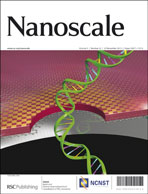Crucial role of the biological barrier at the primary targeted organs in controlling the translocation and toxicity of multi-walled carbon nanotubes in the nematode Caenorhabditis elegans†
Abstract
Multi-walled carbon nanotubes (MWCNTs) can be translocated into the targeted organs of organisms. We employed a model organism of the nematode Caenorhabditis elegans to investigate the role of a biological barrier at the primary targeted organs in regulating the translocation and toxicity formation of MWCNTs. A prolonged exposure to MWCNTs at predicted environmental relevant concentrations caused adverse effects associated with both the primary and secondary targeted organs on nematodes. The function of PEGylated modification in reducing MWCNTs toxicity might be mainly due to the suppression of their translocation into secondary targeted organs through the primary targeted organs. A biological barrier at the primary targeted organs contributed greatly to the control of MWCNTs translocation into secondary targeted organs, as indicated by functions of Mn-SODs required for prevention of oxidative stress in the primary targeted organs. Over-expression of Mn-SODs in primary targeted organs effectively suppressed the translocation and toxicity of MWCNTs. Our work highlights the crucial role of the biological barrier at the primary targeted organs in regulating the translocation and toxicity formation of MWCNTs. Our data also shed light on the future development of engineered nanomaterials (ENMs) with improved biocompatibility and design of prevention strategies against ENMs toxicity.


 Please wait while we load your content...
Please wait while we load your content...